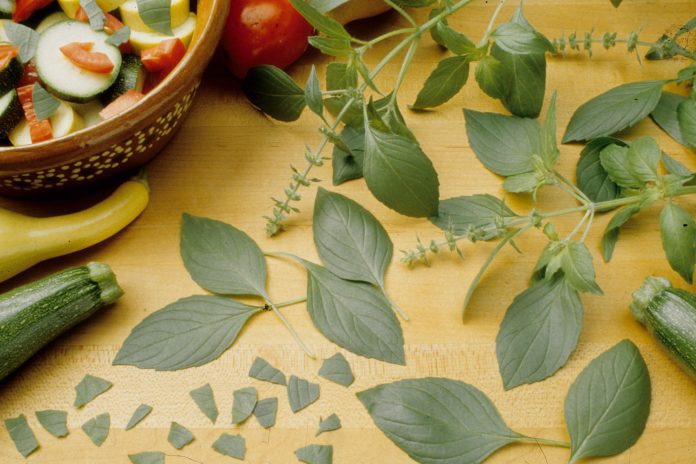

Don’t let a bumper crop of basil go to waste. Preserve its flavor and zest with proper storage and preservation.
Extend the life of fresh basil by removing any discolored leaves and cutting the bottom of the stems off at an angle. Set the stems in a jar with an inch or two of water. Loosely cover it with a plastic bag and set it on the kitchen counter out of direct sunlight. Change the water every few days. Basil stored this way is conveniently located for use and can last for five days or more.
Preserve some basil for future use. Drying herbs is easy but not the best option for basil. The flavor can change during the drying process. If you opt for this method, dry small amounts of basil in bundles hanging upside down. Secure the stems with a rubber band. As the stems shrink, so does the rubber band. Place the bundle in a brown paper bag with the stems sticking out of the bag to dry. Punch holes in the sides of the bag and hang it in a warm dry location where the air can circulate through the bag to speed drying. Avoid binding large amounts of basil together as it is more likely to dry slowly and mold.
Better yet, remove the leaves from the stems of freshly harvested basil. Speed drying with the help of a microwave or dehydrator. Evenly spread two cups of washed herb leaves on a double thickness of paper towel. Microwave on high for four to six minutes depending on your microwave. Follow the manufacturer’s directions when drying basil in a food dehydrator.
Fully dried herbs will be brittle and rattle when stirred. Store dried herbs in an airtight container in a cool, dry and dark location. Label the container with the name of the herb and the date preserved.
Dried herbs are usually three to four times stronger than fresh herbs. To substitute dried herbs in a recipe that calls for fresh herbs, use 1/4 to 1/3 of the amount listed in the recipe.
Freezing is another way to preserve basil. It does change the texture so frozen basil is best used in soups, stews, and other recipes but not as a garnish.
Remove the stems and blanch the leaves in boiling water for three seconds. Then quickly move the leaves to cold water for several seconds to cool quickly. Blanching helps basil retain its green color. Dry the leaves. Once dry, spread the leaves on a tray or cookie sheet and place them in the freezer. Once the leaves are frozen solid move them to airtight containers and store them in the freezer. You can also spread the leaves in layers separated by parchment paper, slide the layers into a freezer bag, then place it flat in the freezer.
Alternatively, chop leaves and place them into an ice cube tray. Fill the empty space with a little water or olive oil depending on how you plan to use it in the future. Allow these to freeze solid. Pop them out of the ice cube tray and place them in an airtight freezer-quality container, label and place them back in the freezer. Pesto can also be frozen using this ice cube method.
Preserving basil when it is bountiful allows you to enjoy it throughout the year. You’ll appreciate the homegrown flavor and money savings.


















